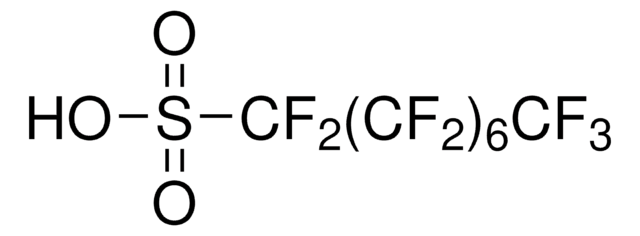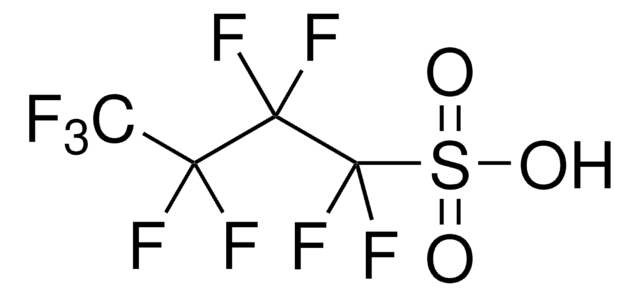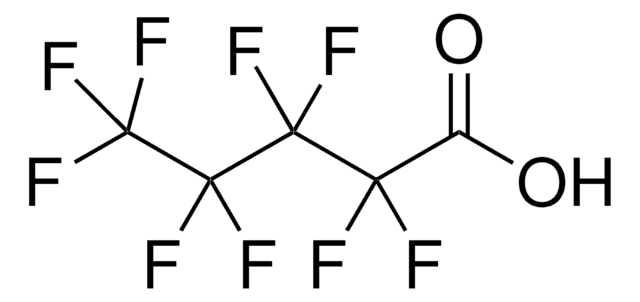추천 제품
분석
97%
양식
solid
mp
59-62 °C (lit.)
SMILES string
OC(=O)C(F)(F)C(F)(F)C(F)(F)C(F)(F)C(F)(F)C(F)(F)C(F)(F)C(F)(F)F
InChI
1S/C9HF17O2/c10-2(11,1(27)28)3(12,13)4(14,15)5(16,17)6(18,19)7(20,21)8(22,23)9(24,25)26/h(H,27,28)
InChI key
UZUFPBIDKMEQEQ-UHFFFAOYSA-N
유사한 제품을 찾으십니까? 방문 제품 비교 안내
관련 카테고리
신호어
Danger
유해 및 위험 성명서
Hazard Classifications
Acute Tox. 4 Inhalation - Acute Tox. 4 Oral - Carc. 2 - Lact. - Repr. 1B - STOT RE 1
표적 기관
Liver
Storage Class Code
6.1C - Combustible acute toxic Cat.3 / toxic compounds or compounds which causing chronic effects
WGK
WGK 3
Flash Point (°F)
Not applicable
Flash Point (°C)
Not applicable
개인 보호 장비
dust mask type N95 (US), Eyeshields, Gloves
이미 열람한 고객
Lin Tao et al.
Environmental science & technology, 42(9), 3472-3478 (2008-06-05)
The collapse of the World Trade Center (WTC) on September 11, 2001 resulted in the release of several airborne pollutants in and around the site. Perfluorochemicals including perfluorooctanesulfonate (PFOS) and perfluorooctanoic acid (PFOA), which are used in soil- and stain-resistant
Xuemei Fang et al.
Toxicology, 267(1-3), 54-59 (2009-11-03)
Perfluoroalkyl acid (PFAA)-induced apoptosis has been reported in many cell types. However, minimal information on its mode of action is available. This study explored the possible involvement of apoptotic signaling pathways in a nine-carbon-chain length PFAA-perfluorononanoic acid (PFNA)-induced splenocyte apoptosis.
Katoria Tatum-Gibbs et al.
Toxicology, 281(1-3), 48-55 (2011-01-18)
Perfluorononanoic acid (PFNA) is a fluorinated organic chemical found at low levels in the environment, but is detectable in humans and wildlife. The present study compared the pharmacokinetic properties of PFNA in two laboratory rodent species. Male and female Sprague-Dawley
Marleen Maras et al.
Environmental health perspectives, 114(1), 100-105 (2006-01-06)
We investigated estrogen-like properties of five perfluorinated compounds using a combination of three in vitro assays. By means of an E-screen assay, we detected the proliferation-promoting capacity of the fluorotelomer alcohols 1H,1H,2H,2H-perfluorooctan-1-ol (6:2 FTOH) and 1H,1H,2H,2H-perfluoro-decan-1-ol (8:2 FTOH). The more
Xuemei Fang et al.
Toxicology, 294(2-3), 109-115 (2012-03-06)
Exposure to perfluorononanoic acid (PFNA), an increasingly persistent organic pollutant that has been detected in abiotic and biotic matrices, has been demonstrated to cause hepatotoxicity in animals. However, the effects of PFNA on hepatic glucose metabolism have not been fully
자사의 과학자팀은 생명 과학, 재료 과학, 화학 합성, 크로마토그래피, 분석 및 기타 많은 영역을 포함한 모든 과학 분야에 경험이 있습니다..
고객지원팀으로 연락바랍니다.











